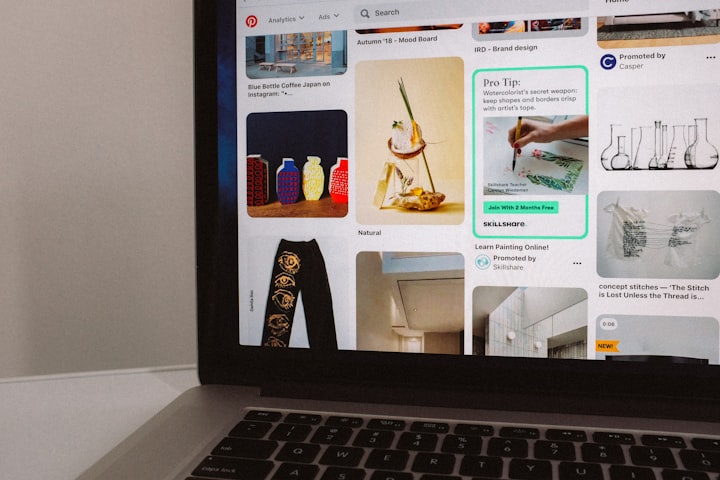Why Does Every Designer Need A Mood Board
Some designers see a mood board as decoration, while others see it as a way to limit creativity. In reality, a mood board is a preliminary concept, the basis on which a design project is built.

For us, a mood board is part of a design search and an easy way to test hypotheses. So we can find points of contact with the client, better feel him and the brand itself, for which we are developing a corporate identity. And also to avoid a situation when the project has already been completely created, and the customer does not like it.
What is a mood board?
Moodboard is a kind of preview of the future design. It is a "mood board" in which the concept of the brand's corporate identity is reflected through photographs, colors, and fonts. It is designed in the form of a collage. We use Pinterest to build it.
Moodboard gives an understanding of what the spirit and mood of the project will be, what images will be put into it. This is the concentration of inspiration for creating a new corporate identity.
You can find hundreds of mood boards on Dribble or Behance - for cases and more. So you can always look there for inspiration. But to understand what a mood board looks like, let's show our assembly according to the GEMSTONE identity.
Why is it needed:
Assembling a mood board means solving five key tasks at once when developing a corporate identity:
- Lay the foundation for a future project. To create a new corporate identity, it is not enough just to have the skills of a designer and start drawing elements. It is important to understand from which side to approach it, where to start. By putting together a mood board, visualizing ideas for a project, you will create a foundation that you can rely on in the future;
- To form a general idea of the final project in the team. More often than not one designer works on a corporate identity, but a whole team. The Moodboard allows everyone to adhere to the same direction, so any new ideas that arise will not be led astray;
- To involve the client in the project at the discussion stage. The client is not always well versed in the design, but only his approval gives the project the green light. By showing visual guidelines at the stage of discussing the corporate identity, you can avoid misunderstandings at the subsequent stage of approval and amendments. A consistent mood board is a way to avoid the comments "this is not what I wanted" / "this is not what I wanted" / "not sure if this is good";
- Facilitate communication. Of course, you can tell the client in words what the idea of the corporate identity will be. It's even better if you send him some visual references. But all this will not give a focus on the idea. Moodboard is needed to collect all ideas in one place and convey them to the client in an understandable visual form. This greatly facilitates communication on the project;
- Save ideas for the future. When you search for visual ideas, you look at hundreds of references. Some of them are suitable for the current project, others may hook, but do not fit into the concept. You can keep them for future reference, save them to your Pinterest account, or save them to your hard drive. So you can not only come up with an idea that you will implement on another project, but you will also actively develop your insight.
How to make a mood board.
Each project has specific tasks. Before you start assembling a mood board, you need to dive into the brand and its product. Understanding its essence, think about what the visual concept should talk about, what associations it should evoke. These are your tips for choosing a style and color scheme.
Let's share how our designers put together a mood board. In total, this process includes 5 stages:
- Finding suitable photos and relationships between them
- Limiting the palette to 3–4 colors
- Selection of 8–10 best photos that convey the essence of the concept
- Selection of fonts
- Working with composition
Search photos.
Use Pinterest. At the start, add as many relevant images to your board as possible. To do this, choose specific words associated with the project. For example, for a jewelry house, it is luxurious, beautiful, stylish… Don't forget to use associations. The more unexpected the association, the more interesting the references will be.
Finding relationships.
Among the collected photos we find patterns - which pictures match each other, which colors are used more often, which mood is traced …
Color palette.
Limit the palette to 3–4 colors. Use one for the background, the rest for accents. It's great when the background color is muted, then others look brighter.
When working with color, look for inspiration in the things around you: nature, architecture, illustrations, films.
Selection of the best images.
Select images with key components of identity - color, font, photo style, graphic elements. Enough 8–10 photos with the most accurate and vivid images.
Selection of fonts.
Depending on the mood of the selected images, select the fonts. It can be a grotesque, a display typeface with curls, a fashionable antique …
Composition.
Make the photos form a picture that is pleasing to look at. If there is freedom in the mood board, make the chaos aware. Think over the location of the photo - the perception of the whole concept depends on it.
Analog or digital.
Let's not open America by saying that all work is now being done in digital. But sometimes it can be helpful to remember the old school version and physically assemble the mood board. The collage technique is best suited for this (overlaying images on top of each other in a chaotic manner).
The physical version of the od board allows you to use not only pictures but also materials: fabric, candy wrappers, tickets, key rings. This makes it even easier to feel the concept of the future corporate identity. In the future, the collage can be photographed and thereby translated into a digital dimension.
A digital mood board may also go beyond just images. Here you can add audio files, GIF animation, video. At the same time, the digital format is much more efficient than the analog one due to the ability to instantly share it and collectively edit the "board".
About the Creator
Michail Bukin
Creative Writing Expert and Ambitious Stutterer






Comments
There are no comments for this story
Be the first to respond and start the conversation.